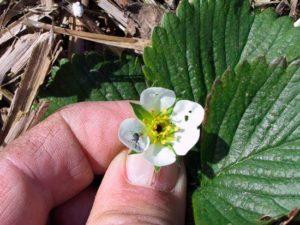Raspberry weevil: a small insect on sweet berries
In the garden and garden there are many different types of beetles, most of which are pests. One of these is considered to be a raspberry flower beetle, an elephant or a weevil - a small beetle with excellent appetite.
Content
Raspberry weevil: photo
Description of the weevil
Name: Raspberry weevil or flower beetle
Latin: Anthonomus rubiClass: Insects - Insecta
Squad: Coleoptera - Coleoptera
Family: Weevils - Curculionidae
 | Habitats: | garden and greenhouse |
 | Dangerous for: | raspberries, strawberries, strawberries |
 | Means of destruction: | chemical, manual collection, traps |
The raspberry-strawberry beetle is a pest that loves strawberries, blackberries, raspberries, strawberries, and also eats cruciferous plants. It infects flower buds, which leads to a decrease in yield. The insect itself is gray-black in color with an elongated proboscis.
Life cycle
The raspberry-strawberry weevil has a full life cycle. In the spring, the beetles begin to wake up, cutting through the leaves. They lay eggs in buds, and one female can lay 50 eggs and each testicle in a separate bud.
The legless grey-white larvae reproduce and grow inside the bud. Interestingly, the females gnaw the pedicels so that the bud falls to the ground, otherwise the larva will die.
During the ripening of the berries, pupation occurs, and the young generation beetles feed on young leaves and late records. They also overwinter in the ground directly under the crops.
The danger is that these beetles are actively migrating. At the beginning of the season, they begin to eat early varieties of strawberries and strawberries, and then the weevil migrates to raspberries and other berries.
How to identify damage
It is quite difficult to notice a small beetle; you will need to carefully examine the landings. But in early spring, you can notice pinpoint punctures on the leaves, as well as their sharp fall.
It is worth paying attention to those buds that are on long pedicels and rise above the bushes. They must be immediately checked and removed if an egg is found in them. The procedure is not easy, because females lay eggs gradually over the course of a month.
However, if preventive procedures are carried out in a timely manner, the weevil population can be significantly reduced.
Preventive measures
Prevention of the appearance of the raspberry-strawberry weevil is:
- Planting garlic and onions between the rows, as well as marigolds, marigolds or nasturtiums.
- In autumn, it is necessary to dig around the bushes to reduce the number of beetles that have left for the winter.
- After a full harvest, it is better to cut off the green parts.
- Plant varieties with a short flowering period.
- Place raspberries, strawberries and strawberries on the site as far as possible.
How to deal with the raspberry-strawberry weevil
Immediately at the beginning of the warm season, it is recommended to prevent the appearance of pests. If this does not help to remove them all, then at least it will reduce the number. There are several basic methods of struggle.
Trap or lure
In order to lure the beetles, a fermentation mixture is prepared. You need half a liter of water, 100 g of sugar and 50 g of dry yeast. Mix everything in a container and leave under the bushes. You can make several traps at once.
The required containers must have a narrow neck. Beetles climb into this solution, which attracts them with a smell, but they can no longer get out. You will have to change baits in the process of flowering fruit crops every 2-3 days.
Biological methods
These include attracting birds and beneficial insects that eat weevils and their larvae. The ground beetle is considered the very first, which is a predator on these and other types of pests.
Folk methods
These are infusions and decoctions that act safely, but are ineffective when widely distributed. Here are some recipes.
| Preparation | Using |
| Hot chilli pepper | To prepare an infusion for a bucket of water, you will need to use 1 kg of fresh or 500 g of dry chopped pepper. It takes 2 days to prepare. |
| Tansy | Insist for 2 days 300 grams of a dry plant or 1 kg of fresh. Then boil the mixture for half an hour, dilute with water 1: 1 and spray. |
| Mustard | 200 grams of dry powder is diluted in 5 liters of water. You can spray the mixture every 10 days. |
| Onion and celandine | It is necessary to place 2 parts of onion peel and one part of celandine in a 3-liter jar and pour hot water over it. You can spray immediately after cooling. |
| Čemerica | For 1 kg of fresh celandine grass, you need a liter of water, boil and cool. Add clean water to make a bucket and use for spraying. |
In each of these solutions, just before spraying, you need to add a little grated laundry soap for better adhesion.
Chemicals
You need to be very careful to use strawberries and strawberries on raspberries. They can be used only before flowering or after harvesting to process the bushes, remove those beetles that have just appeared under the first warm rays and those that are going to leave for the winter. Apply Fufanon, Karbofos, Novatenol and Alatar according to the instructions.
Conclusion
When the first greenery appears on the site, you need to carefully inspect the plantings for the appearance of pests. The raspberry-strawberry beetle can spoil a lot of berries very quickly.
Previous
